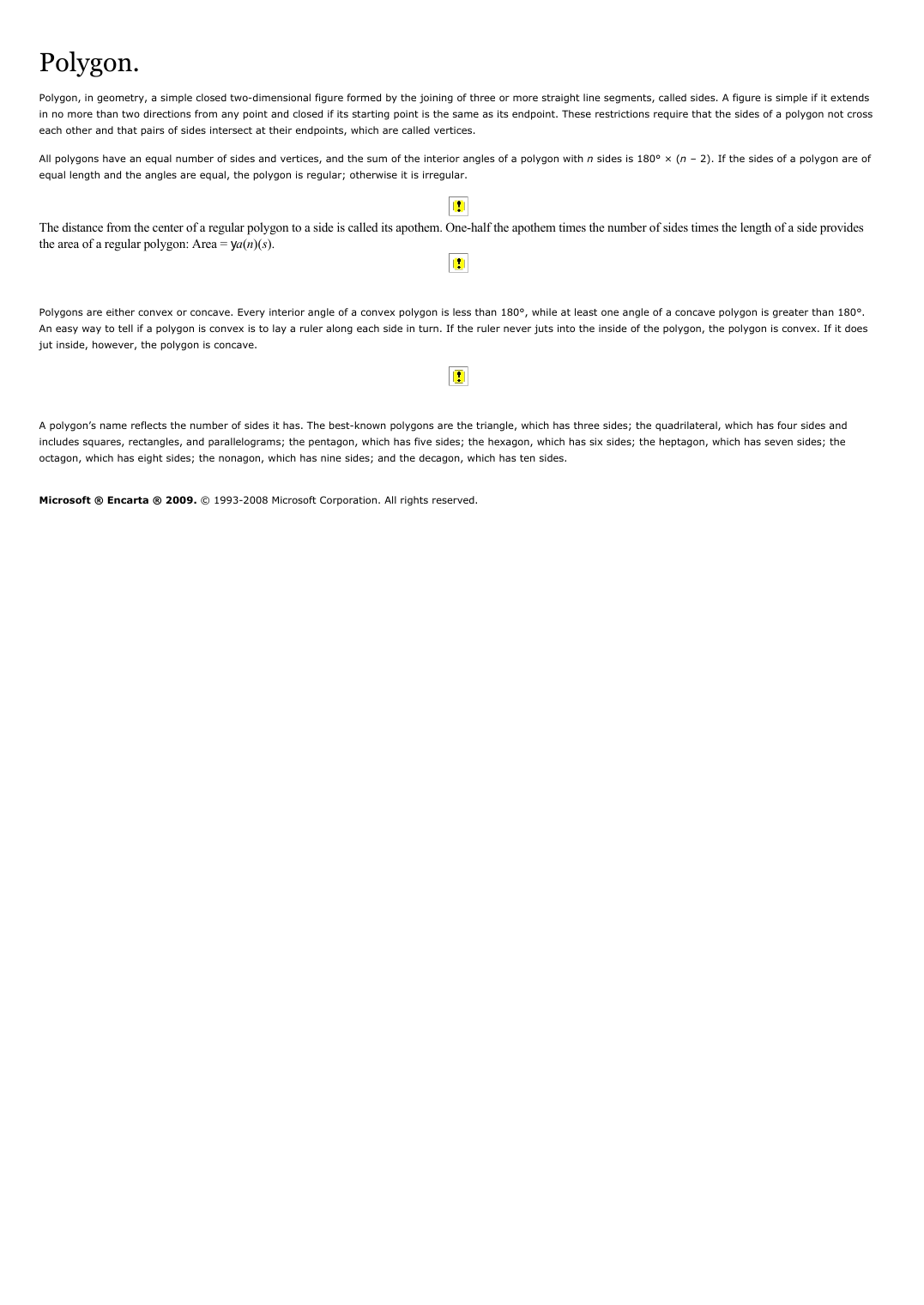Polygon.
Publié le 06/12/2021

Extrait du document
Ci-dessous un extrait traitant le sujet : Polygon.. Ce document contient 324 mots. Pour le télécharger en entier, envoyez-nous un de vos documents grâce à notre système d’échange gratuit de ressources numériques ou achetez-le pour la modique somme d’un euro symbolique. Cette aide totalement rédigée en format pdf sera utile aux lycéens ou étudiants ayant un devoir à réaliser ou une leçon à approfondir en : Echange
Polygon.
Polygon, in geometry, a simple closed two-dimensional figure formed by the joining of three or more straight line segments, called sides. A figure is simple if it extends
in no more than two directions from any point and closed if its starting point is the same as its endpoint. These restrictions require that the sides of a polygon not cross
each other and that pairs of sides intersect at their endpoints, which are called vertices.
All polygons have an equal number of sides and vertices, and the sum of the interior angles of a polygon with n sides is 180° × (n - 2). If the sides of a polygon are of
equal length and the angles are equal, the polygon is regular; otherwise it is irregular.
The distance from the center of a regular polygon to a side is called its apothem. One-half the apothem times the number of sides times the length of a side provides
the area of a regular polygon: Area = ya(n)(s).
Polygons are either convex or concave. Every interior angle of a convex polygon is less than 180°, while at least one angle of a concave polygon is greater than 180°.
An easy way to tell if a polygon is convex is to lay a ruler along each side in turn. If the ruler never juts into the inside of the polygon, the polygon is convex. If it does
jut inside, however, the polygon is concave.
A polygon's name reflects the number of sides it has. The best-known polygons are the triangle, which has three sides; the quadrilateral, which has four sides and
includes squares, rectangles, and parallelograms; the pentagon, which has five sides; the hexagon, which has six sides; the heptagon, which has seven sides; the
octagon, which has eight sides; the nonagon, which has nine sides; and the decagon, which has ten sides.
Microsoft ® Encarta ® 2009. © 1993-2008 Microsoft Corporation. All rights reserved.
Polygon.
Polygon, in geometry, a simple closed two-dimensional figure formed by the joining of three or more straight line segments, called sides. A figure is simple if it extends
in no more than two directions from any point and closed if its starting point is the same as its endpoint. These restrictions require that the sides of a polygon not cross
each other and that pairs of sides intersect at their endpoints, which are called vertices.
All polygons have an equal number of sides and vertices, and the sum of the interior angles of a polygon with n sides is 180° × (n - 2). If the sides of a polygon are of
equal length and the angles are equal, the polygon is regular; otherwise it is irregular.
The distance from the center of a regular polygon to a side is called its apothem. One-half the apothem times the number of sides times the length of a side provides
the area of a regular polygon: Area = ya(n)(s).
Polygons are either convex or concave. Every interior angle of a convex polygon is less than 180°, while at least one angle of a concave polygon is greater than 180°.
An easy way to tell if a polygon is convex is to lay a ruler along each side in turn. If the ruler never juts into the inside of the polygon, the polygon is convex. If it does
jut inside, however, the polygon is concave.
A polygon's name reflects the number of sides it has. The best-known polygons are the triangle, which has three sides; the quadrilateral, which has four sides and
includes squares, rectangles, and parallelograms; the pentagon, which has five sides; the hexagon, which has six sides; the heptagon, which has seven sides; the
octagon, which has eight sides; the nonagon, which has nine sides; and the decagon, which has ten sides.
Microsoft ® Encarta ® 2009. © 1993-2008 Microsoft Corporation. All rights reserved.
↓↓↓ APERÇU DU DOCUMENT ↓↓↓


